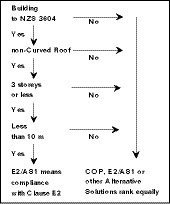New Building Regulations
Acceptable Solution E2/AS1 External Moisture
Improvements in building products, designs and processes over a number of years have contributed to better built environments. The 2004 Building Act was intended to regulate for the continuation and enhancement of this improvement process.
The publication on 1 July 2005 of the new Acceptable Solution E2/AS1 by the Department of Building and Housing (DBH) aims to re-emphasise the provision of quality practices in building design and construction.
Changes to the provisions in the new E2/AS1 have a number of important implications for designers, building practitioners, and users of metal clad buildings in New Zealand.
Clause E2 is one of 35 clauses of the New Zealand Building Code and deals specifically with External Moisture. It says that buildings must “provide adequate resistance to penetration by, or accumulation of, water from the outside ”.
The updating of E2/AS1 was part of the recommendation of The Report of the Overview Group on the Weathertightness of Buildings in August 2002.
Spanning the period of revision of E2/AS1, the NZ Metal Roofing Manufacturers (MRM) produced the far more comprehensive Code of Practice for Metal Roof and Wall Cladding which was intended as the definitive document for the industry.
MRM also contributed comprehensively to the formulation of the new E2/AS1 over two and a half years, and E2/AS1 does refer users to the NZ Metal Roof and Wall Cladding Code of Practice (COP) for additional guidance in a number of places where more detail is required, although this is in the form of non-mandatory comment only.
 The scope of E2/AS1 is only for buildings constructed according NZS 3604:1999 “Timber Framed Buildings”, it is limited to 3-storey buildings less than 10 m high and it does not include curved roofs. The COP covers all buildings with metal roof or wall cladding and so has a much wider scope than E2/AS1.
The scope of E2/AS1 is only for buildings constructed according NZS 3604:1999 “Timber Framed Buildings”, it is limited to 3-storey buildings less than 10 m high and it does not include curved roofs. The COP covers all buildings with metal roof or wall cladding and so has a much wider scope than E2/AS1.
While the Building Code itself is “performance” based, Acceptable Solutions such as E2/AS1 are provided as one “prescriptive” method of meeting the Building Code.
An “Alternative Solution” may be used instead provided it can be shown to meet the performance based requirements of the Building Code, but this may need to be demonstrated for every installation.
Acceptable Solutions like E2/AS1 are not mandatory and Building Control Authorities (BCAs) are required to consider Alternative Solutions if they can be satisfied of compliance with the Building Code on 'Reasonable Grounds'. In practice however, the Acceptable Solution is generally preferred because of the effort required to show that Alternative Solutions do meet the performance requirements of the Building Code, and also because the DBH assumes liability for details in E2/AS1. The MRM and the DBH have worked hard to produce documentation containing good trade practice for metal roof and wall cladding, but changes will continue to be made to Building Codes and Standards over the next few years.
NZ Metal Roofing Manufacturers will continue to play a very active part in ensuring that good trade practice in metal roof and wall cladding is implemented for quality building under New Zealand conditions.
For various reasons there are some differences between E2/AS1 and the MRM specification for good trade practice as per the COP, and these fall into four classes:-
1. Areas where E2/AS1 is more conservative than the COP
It is desirable for the Building Consent to specify the use of the NZ Metal Roof and Wall Cladding Code of Practice. Where the Building Consent (a legal contract) specifies use of the COP, then the COP applies in place of E2/AS1. Otherwise, for buildings where E2/AS1 applies as shown in the table, the provisions of E2/AS1 may need to be followed
2. Areas where the COP is more conservative than E2/AS1.
Use of more conservative practices than shown in E2/AS1 still comply with E2, and in these instances the COP should continue to be applied as it provides the appropriate specification for good trade practice which may not be in E2/AS1 at this point.
3. Areas where E2/AS1 does not provide sufficient information to cover more than limited situations and may refer to the COP. Here the COP will need to be used.
4. There are some limited provisions in E2/AS1 which are not practical and here the COP should be followed to avoid damage or loss of durability.
